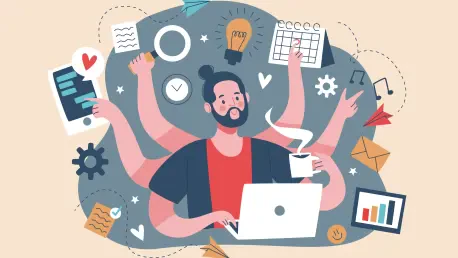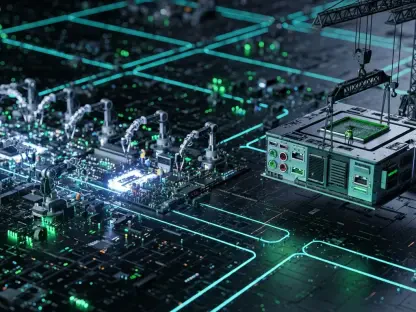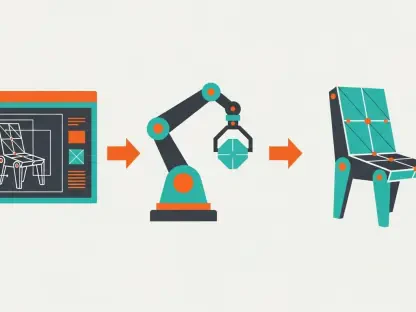In the fast-paced landscape of 2025, where workloads seem to grow heavier by the day and distractions lurk around every digital corner, artificial intelligence (AI) emerges as a transformative force for productivity, offering new ways to manage time and tasks. Professionals across industries, along with students and entrepreneurs, grapple with the constant pressure to accomplish more in shrinking timeframes, often at the cost of mental clarity and personal balance. AI tools, now deeply integrated into everyday applications, offer a compelling solution by automating mundane tasks, optimizing schedules, and providing actionable insights into work habits. This isn’t merely a trend but a practical shift, enabling individuals and teams to break free from the cycle of overwhelm and focus on what truly drives impact.
The promise of AI lies in its ability to act as an ever-present assistant, handling repetitive chores like email management or data entry while suggesting smarter ways to structure the day. Picture a scenario where hours once lost to administrative burdens are reclaimed for creative problem-solving or strategic planning. These tools span a wide array of functions, from task management to collaborative platforms, adapting to diverse needs whether one operates solo or within a sprawling team. As burnout becomes an increasing concern in modern work culture, AI steps in not just to save time, but to reduce stress by creating breathing room in packed schedules. This article explores the key areas where AI is reshaping productivity, delving into specific benefits and applications that could redefine daily routines in profound ways.
The Power of Automation
Streamlining Repetitive Tasks
Automation stands as a cornerstone of AI’s impact on productivity, effectively eliminating the drudgery of repetitive tasks that sap time and energy. In 2025, sophisticated tools can sort through overflowing inboxes, categorize emails by priority, and even draft basic responses without any manual input. Beyond communication, these systems manage data entry, update project trackers, and handle routine approvals, significantly cutting down on human error. This shift allows professionals to redirect their focus toward high-value activities, such as brainstorming innovative solutions or building client relationships, rather than getting bogged down in logistical minutiae. The result is a workday that feels less cluttered and more purposeful, with mental bandwidth preserved for critical thinking.
Moreover, the scope of automation extends to personal organization as much as professional demands. AI can manage reminders for deadlines, organize digital files, and even automate expense tracking by syncing with financial apps. Such capabilities mean that even small, time-consuming tasks no longer accumulate into major stressors. For teams, automated notifications ensure that everyone stays updated without the need for constant manual follow-ups. This creates a smoother operational flow, where the focus remains on outcomes rather than processes. By stripping away these repetitive burdens, AI fosters an environment where productivity isn’t just about doing more, but doing what matters most.
Enhancing Workflow Efficiency
AI’s role in automation goes beyond isolated tasks, extending to the optimization of entire workflows through seamless integration across platforms. Tools in 2025 can connect disparate apps, ensuring that data flows effortlessly from one system to another without user intervention. For instance, a project update entered in one tool can automatically reflect in related dashboards or trigger notifications in communication channels. This level of synchronization eliminates the need to toggle between multiple applications, saving time and reducing the risk of oversight. Businesses benefit from streamlined operations, as teams can focus on execution rather than wrestling with fragmented systems.
Additionally, workflow automation tackles inefficiencies by identifying bottlenecks before they escalate into major delays. AI analyzes patterns in project timelines or resource allocation, offering suggestions to reassign tasks or adjust priorities for maximum efficiency. This proactive approach ensures that potential hiccups are addressed early, maintaining momentum across complex initiatives. For individuals, automated workflows mean less time spent on planning and more on action, as AI can map out dependencies and suggest the next steps. The cumulative effect is a productivity ecosystem where every component works in harmony, empowering users to achieve consistent progress without the friction of manual coordination.
Mastering Time Management
Intelligent Scheduling Solutions
Time management receives a significant boost from AI through intelligent scheduling solutions that adapt to ever-changing priorities. These tools in 2025 go far beyond static calendars, dynamically arranging tasks and meetings based on urgency and personal work patterns. By analyzing deadlines, workload distribution, and even energy levels inferred from past behavior, AI ensures that the most critical items are tackled at optimal times. This adaptability prevents the exhaustion of decision fatigue, as the system takes on the burden of constant reshuffling. A well-organized day becomes less about wrestling with a to-do list and more about executing with precision.
Furthermore, these scheduling tools integrate with team calendars to find mutually convenient slots for collaboration, reducing the back-and-forth often associated with meeting planning. They can also block off focus periods, safeguarding time for deep work amidst a sea of potential interruptions. If an urgent task arises, the AI recalibrates the schedule in real time, ensuring nothing falls through the cracks. This flexibility is particularly valuable in dynamic environments where priorities shift without warning. By acting as a proactive timekeeper, AI transforms the calendar into a strategic asset, enabling users to navigate their day with confidence and clarity rather than stress.
Insights into Productivity Habits
Beyond scheduling, AI provides deep insights into how time is actually spent, shining a light on hidden productivity gaps. Tools designed for this purpose track digital activity across devices, revealing patterns such as excessive time on non-essential apps or frequent context-switching that disrupts focus. In 2025, these platforms deliver detailed reports, breaking down hours spent on various tasks and categorizing them by impact. Armed with this data, individuals can make informed adjustments, perhaps allocating more time to high-priority projects or cutting down on distractions. This self-awareness fosters a disciplined approach to work, grounded in evidence rather than guesswork.
Equally important is the ability of these tools to suggest actionable improvements based on the collected data. For example, if analysis shows prolonged periods of low productivity in the late afternoon, the system might recommend scheduling lighter tasks during that window or inserting a break to recharge. Some even offer features to set goals for focused work sessions, nudging users toward better habits with gentle reminders. This continuous feedback loop ensures that productivity isn’t a static target but an evolving practice, refined over time. By highlighting where inefficiencies lie and offering tailored solutions, AI empowers users to take control of their time in a way that feels both achievable and sustainable.
Boosting Communication and Collaboration
Bridging Remote Work Gaps
As remote and hybrid work environments remain prevalent in 2025, AI plays a pivotal role in bridging communication gaps that distance can create. Advanced tools transcribe meetings in real time, capturing every spoken word into searchable text, ensuring that no critical detail is missed even if participants are in different time zones. These transcriptions can be summarized to highlight key points and action items, making follow-up more efficient. Additionally, shared digital workspaces powered by AI enable teams to brainstorm, edit, and organize projects collaboratively, replicating the immediacy of in-person interaction. Such capabilities keep everyone aligned, fostering a sense of unity despite physical separation.
The impact of these tools extends to preserving institutional knowledge within teams. AI systems store and categorize meeting records, creating an accessible archive that new members can reference to get up to speed quickly. This reduces the learning curve and prevents the loss of vital information during staff transitions. Moreover, features like automated translation within communication platforms break down language barriers, enabling global teams to collaborate seamlessly. By addressing the logistical and cultural challenges of remote work, AI ensures that distance becomes an afterthought, allowing teams to focus on shared goals with clarity and cohesion.
Automating Team Updates
AI also revolutionizes team communication by automating routine updates and reducing the need for manual check-ins. In 2025, platforms can send automated notifications about project progress, task completions, or pending approvals directly within chat systems or dashboards. This eliminates the endless email threads or status meetings that often clutter schedules, ensuring that relevant information reaches the right people at the right time. Teams benefit from a streamlined flow of updates, where the focus shifts from chasing information to acting on it. This efficiency is especially crucial for large groups where coordination can easily become unwieldy.
In addition, AI can prioritize which updates require immediate attention, filtering out noise and highlighting urgent matters for quick resolution. For instance, if a deadline is at risk, the system can alert key stakeholders and suggest contingency steps based on past project data. This intelligent curation prevents information overload, a common issue in fast-moving environments. By automating these communication touchpoints, AI not only saves time but also enhances accountability, as team members can trust that critical updates won’t slip through unnoticed. The result is a collaborative dynamic where transparency and responsiveness coexist without adding to anyone’s workload.
Unlocking Personalization and Adaptability
Tailoring Solutions to Individual Needs
One of the standout features of AI in 2025 is its capacity for personalization, adapting to individual preferences and work styles with remarkable precision. Unlike generic productivity tools, these systems learn from user behavior over time, customizing suggestions for everything from task prioritization to email tone. For example, a content creator might receive tailored prompts for writing ideas, while a project manager gets insights on team workload distribution. This bespoke approach ensures that the technology feels like a natural extension of one’s workflow, rather than a rigid framework to conform to, making adoption intuitive.
This personalization also manifests in how AI integrates with daily routines across various devices and platforms. Voice-activated assistants can set reminders or control smart environments hands-free, aligning with a user’s pace and preferences. Meanwhile, writing tools adjust feedback based on the intended audience, whether crafting a formal report or a casual update. By molding itself to specific needs, AI eliminates the one-size-fits-all barrier that often discourages tech adoption. The outcome is a productivity experience that feels uniquely supportive, enhancing efficiency in a way that respects individual differences and evolving demands.
Seamless Integration into Existing Systems
The adaptability of AI shines further through its seamless integration into tools and platforms already in use, minimizing disruption. In 2025, productivity suites embed AI features directly into familiar interfaces like word processors or messaging apps, allowing users to leverage advanced capabilities without learning new systems. For instance, drafting a document might include real-time content suggestions, while a chat platform automates routine responses or task assignments. This native presence ensures that the benefits of AI are accessible to even those hesitant about technology, as the learning curve is virtually nonexistent.
Moreover, AI’s ability to connect disparate applications creates a unified digital ecosystem where data and actions flow effortlessly. A task created in one app can trigger updates in another, ensuring consistency across workflows without manual input. This interoperability is particularly valuable for organizations using a mix of legacy and modern tools, as AI bridges compatibility gaps. By embedding itself into existing structures, AI not only enhances functionality but also encourages widespread use, proving that transformative productivity gains don’t require a complete overhaul. Instead, they build on what’s already in place, amplifying effectiveness with minimal friction.
Reflecting on AI’s Transformative Impact
Looking back, the integration of AI tools into productivity frameworks marked a significant shift in how challenges like overwhelming workloads and fragmented focus were addressed. Automation handled the repetitive grind, time management solutions brought order to chaotic schedules, and communication platforms ensured teams stayed connected despite physical distances. Personalization and adaptability further cemented AI’s role, tailoring assistance to unique needs while embedding seamlessly into familiar systems. These advancements redefined efficiency, proving that technology could alleviate stress and create space for meaningful work.
Moving forward, the focus should be on intentional adoption, selecting tools that align with specific goals and challenges rather than chasing every new feature. Experimentation with different platforms can reveal which solutions deliver the most value, while regular review of productivity data ensures ongoing improvement. As AI continues to evolve from 2025 onward, staying informed about emerging capabilities will be key to maintaining a competitive edge. Ultimately, the legacy of these tools lies in their empowerment of individuals and teams to achieve more with less effort, paving the way for a balanced, impactful approach to both work and life.









